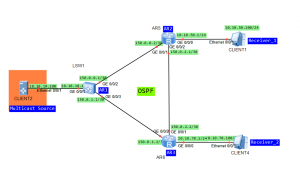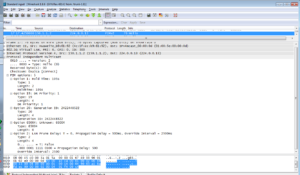I wanted to use AR routers to prepare PIM SM lab but it turned out that there is a problem with cooperation between multicast source and AR router. Of course I am talking about network simulator eNSP. Finally I decided to use eNSP with S5700. So we have topology like in the last two posts:
- Configure VLANs, VLAN interfaces and IP addresses based on the topology (omitted).
- Configure OSPF to ensure connectivity between switches (omitted).
- Enable multicast on both switches.
- Enable PIM SM on all interfaces.
- Enable IGMP on receivers’ interfaces.
- Set static RP for both switches (Loopback0 of SwitchB).
- Address of multicast group G: 225.1.1.1.
- Address of multicast group S: 10.10.10.100.
Display IP routing tables of both switches:
[SwitchA]dis ip routing-table
Route Flags: R - relay, D - download to fib
------------------------------------------------------------------------------
Routing Tables: Public
Destinations : 9 Routes : 9
Destination/Mask Proto Pre Cost Flags NextHop Interface
1.1.1.1/32 OSPF 10 1 D 150.1.1.1 Vlanif300
10.10.10.0/24 OSPF 10 2 D 150.1.1.1 Vlanif300
10.10.20.0/24 OSPF 10 2 D 150.1.1.1 Vlanif300
10.10.30.0/24 Direct 0 0 D 10.10.30.1 Vlanif400
10.10.30.1/32 Direct 0 0 D 127.0.0.1 Vlanif400
127.0.0.0/8 Direct 0 0 D 127.0.0.1 InLoopBack0
127.0.0.1/32 Direct 0 0 D 127.0.0.1 InLoopBack0
150.1.1.0/30 Direct 0 0 D 150.1.1.2 Vlanif300
150.1.1.2/32 Direct 0 0 D 127.0.0.1 Vlanif300
[SwitchB]dis ip routing-table
Route Flags: R - relay, D - download to fib
------------------------------------------------------------------------------
Routing Tables: Public
Destinations : 10 Routes : 10
Destination/Mask Proto Pre Cost Flags NextHop Interface
1.1.1.1/32 Direct 0 0 D 127.0.0.1 LoopBack0
10.10.10.0/24 Direct 0 0 D 10.10.10.1 Vlanif100
10.10.10.1/32 Direct 0 0 D 127.0.0.1 Vlanif100
10.10.20.0/24 Direct 0 0 D 10.10.20.1 Vlanif200
10.10.20.1/32 Direct 0 0 D 127.0.0.1 Vlanif200
10.10.30.0/24 OSPF 10 2 D 150.1.1.2 Vlanif300
127.0.0.0/8 Direct 0 0 D 127.0.0.1 InLoopBack0
127.0.0.1/32 Direct 0 0 D 127.0.0.1 InLoopBack0
150.1.1.0/30 Direct 0 0 D 150.1.1.1 Vlanif300
150.1.1.1/32 Direct 0 0 D 127.0.0.1 Vlanif300
Enable multicast on both switches:
[SwitchA]multicast routing-enable [SwitchB]multicast routing-enable
Enable PIM SM on all interfaces and IGMP on receivers’ interfaces:
[SwitchA]dis cur int Vlanif # interface Vlanif300 ip address 150.1.1.2 255.255.255.252 pim sm # interface Vlanif400 ip address 10.10.30.1 255.255.255.0 pim sm igmp enable # [SwitchB]dis cur interface Vlanif # interface Vlanif100 ip address 10.10.10.1 255.255.255.0 pim sm # interface Vlanif200 ip address 10.10.20.1 255.255.255.0 pim sm igmp enable # interface Vlanif300 ip address 150.1.1.1 255.255.255.252 pim sm #
Verify PIM and IGMP (SwitchA as an example):
[SwitchA]dis pim neighbor VPN-Instance: public net Total Number of Neighbors = 1 Neighbor Interface Uptime Expires Dr-Priority BFD-Session 150.1.1.1 Vlanif300 00:07:44 00:01:31 1 N [SwitchA]display pim interface VPN-Instance: public net Interface State NbrCnt HelloInt DR-Pri DR-Address Vlanif300 up 1 30 1 150.1.1.2 (local) Vlanif400 up 0 30 1 10.10.30.1 (local) [SwitchA]dis igmp interface Interface information Vlanif400(10.10.30.1): IGMP is enabled Current IGMP version is 2 IGMP state: up IGMP group policy: none IGMP limit: - Value of query interval for IGMP (negotiated): - Value of query interval for IGMP (configured): 60 s Value of other querier timeout for IGMP: 0 s Value of maximum query response time for IGMP: 10 s Querier for IGMP: 10.10.30.1 (this router)
Jul 15 2014 10:18:44.880.2-08:00 SwitchA PIM/7/NBR:(public net): PIM ver 2 HEL se nding 150.1.1.2 -> 224.0.0.13 on Vlanif300 (P012213) Jul 15 2014 10:18:44.880.3-08:00 SwitchA PIM/7/NBR:(public net): Option: 1, lengt h: 2 (P012260) Jul 15 2014 10:18:44.880.4-08:00 SwitchA PIM/7/NBR:(public net): Holdtime: 105 (P 012278) Jul 15 2014 10:18:44.880.5-08:00 SwitchA PIM/7/NBR:(public net): Option: 19, leng th: 4 (P012260) Jul 15 2014 10:18:44.880.6-08:00 SwitchA PIM/7/NBR:(public net): DR priority: 1 ( P012324) Jul 15 2014 10:18:44.880.7-08:00 SwitchA PIM/7/NBR:(public net): Option: 20, leng th: 4 (P012260) Jul 15 2014 10:18:44.880.8-08:00 SwitchA PIM/7/NBR:(public net): GenID: 0X9063A18 A (P012343) Jul 15 2014 10:18:44.880.9-08:00 SwitchA PIM/7/NBR:(public net): Option: 65004, l ength: 0 (P012260) Jul 15 2014 10:18:44.880.10-08:00 SwitchA PIM/7/NBR:(public net): Unknown option value: (P012462) Jul 15 2014 10:18:44.880.11-08:00 SwitchA PIM/7/NBR:(public net): Option: 2, leng th: 4 (P012260) Jul 15 2014 10:18:44.880.12-08:00 SwitchA PIM/7/NBR:(public net): Tbit: unset (P 012300) Jul 15 2014 10:18:44.880.13-08:00 SwitchA PIM/7/NBR:(public net): Lan delay: 500 (P012303) Jul 15 2014 10:18:44.880.14-08:00 SwitchA PIM/7/NBR:(public net): Override interv al: 2500 (P012306)
During neighbor discovery process, each PIM device sends Hello messages. Then DR election is performed, based on carrying the DR priority. The PIM device with the highest DR priority wins. If PIM devices have the same DR priority , the PIM device with the highest IP address wins. There are 2 multicast DRs:
- multicast source DR – responsible for sending Register messages to RP (Rendezvous Point)
- multicast receiver DR – responsible for forwarding multicast data to the group members.
Set static RP for both switches:
[SwitchA]pim
[SwitchA-pim]static-rp 1.1.1.1
[SwitchB]pim
[SwitchB-pim]static-rp 1.1.1.1
[SwitchA-pim]display pim rp-info
VPN-Instance: public net
PIM SM static RP Number:1
Static RP: 1.1.1.1
A static RP is recommended on small and mid-sized networks. A dynamic RP can be used on a large-scale network to improve network reliability and maintainability. In dynamic RP, candidate BSRs and RPs must be configured. Elected BSR collects RP information, summarizes that information into an RP-set and advertises the RP-set to the entire PIM-SM network.
When the source sends the first multicast packet to a multicast group G, the source’s DR encapsulates the multicast packet in a Register message and unicasts it to the RP. An (S, G) entry is created on the RP and source information is registered. When a new group member appears on the network, the receiver’s DR on the group member side sends a JOIN message to the RP. A (*, G) entry is created hop by hop and an RPT with the RP as the root is generated.
<SwitchA>dis pim routing-table
VPN-Instance: public net
Total 1 (*, G) entry; 1 (S, G) entry
(*, 225.1.1.1)
RP: 1.1.1.1
Protocol: pim-sm, Flag: WC
UpTime: 00:01:50
Upstream interface: Vlanif300
Upstream neighbor: 150.1.1.1
RPF prime neighbor: 150.1.1.1
Downstream interface(s) information:
Total number of downstreams: 1
1: Vlanif400
Protocol: igmp, UpTime: 00:01:50, Expires: -
(10.10.10.100, 225.1.1.1)
RP: 1.1.1.1
Protocol: pim-sm, Flag: SPT ACT
UpTime: 00:05:57
Upstream interface: Vlanif300
Upstream neighbor: 150.1.1.1
RPF prime neighbor: 150.1.1.1
Downstream interface(s) information:
Total number of downstreams: 1
1: Vlanif400
Protocol: pim-sm, UpTime: 00:01:50, Expires: -
Debugging PIM and IGMP shows how RPT is created:
<SwitchA> Jul 15 2014 11:02:17.140.1-08:00 SwitchA IGMP/7/REPORT:Received v2 report for gro up 225.1.1.1 on interface Vlanif400(10.10.30.1) (G082859) Jul 15 2014 11:02:17.140.2-08:00 SwitchA PIM/7/ROUT:(public net): PIM-SM: Create (*, 225.1.1.1) entry in mrt. (S0116518) Jul 15 2014 11:02:17.140.3-08:00 SwitchA PIM/7/ROUT:(public net): PIM-SM: Adding iif Vlanif300 to (0.0.0.0, 225.1.1.1). (S014449) Jul 15 2014 11:02:17.140.4-08:00 SwitchA PIM/7/ROUT:(public net): PIM-SM: Add oif : Vlanif400 (10.10.30.1) for (10.10.10.100, 225.1.1.1) (S0114105) Jul 15 2014 11:02:17.140.5-08:00 SwitchA PIM/7/ROUT:(public net): PIM-SM: Deletin g iif 150.1.1.2 from (10.10.10.100, 225.1.1.1). (S013702) Jul 15 2014 11:02:17.140.6-08:00 SwitchA PIM/7/ROUT:(public net): PIM-SM: Adding iif 150.1.1.2 to (10.10.10.100, 225.1.1.1). (S014195) Jul 15 2014 11:02:17.140.7-08:00 SwitchA IGMP/7/EVENT:Creating group(225.1.1.1) f or interface Vlanif400(10.10.30.1) (G014427) Jul 15 2014 11:02:17.140.8-08:00 SwitchA IGMP/7/TIMER:Enqueue group(225.1.1.1) on interface Vlanif400(10.10.30.1) in group_calq. (G016648) Jul 15 2014 11:02:17.140.9-08:00 SwitchA PIM/7/JP:(public net): PIM ver 2 JP sen ding 150.1.1.2 -> 224.0.0.13 on Vlanif300 (P012933) Jul 15 2014 11:02:17.140.10-08:00 SwitchA PIM/7/JP:(public net): Upstream 150.1.1 .1, Groups 1, Holdtime 210 (P012939) Jul 15 2014 11:02:17.140.11-08:00 SwitchA PIM/7/JP:(public net): Group: 225.1.1.1 /32 --- 2 joins 0 prune (P012949) Jul 15 2014 11:02:17.140.12-08:00 SwitchA PIM/7/JP:(public net): Join: 1.1.1.1/32 SWR (P012959) Jul 15 2014 11:02:17.140.13-08:00 SwitchA PIM/7/JP:(public net): Join: 10.10.10.1 00/32 S (P012959)
When a group member and a multicast source that sends multicast data to the group appear on the network, multicast data is encapsulated in a Register message and then unicasted to the RP. The RP then forwards the multicast data along the RPT to group members. As RPT doesn’t have to be a shortest path (SPT), SPT switchover is performed. By default, the RP performs SPT switchover immediately after receiving the first Register message and the receiver’s DR performs SPT switchover immediately after receiving the first multicast packet. Then multicast packets are transmitted based on the SPT.
 Labnario Huawei From Scratch
Labnario Huawei From Scratch

